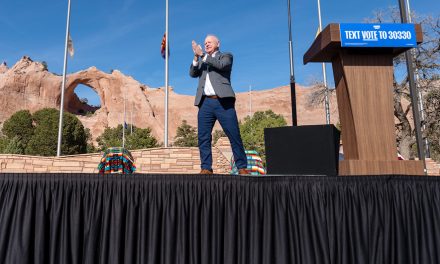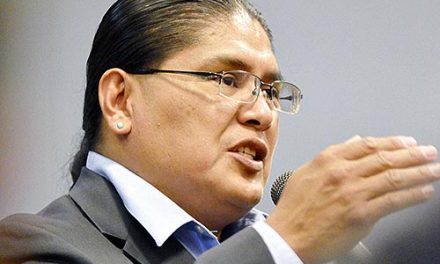
Letters: I want to learn Navajo, but no teacher
Yá’át’ééh, hello, I really enjoyed reading about the article on the Navajo language and how it may be lost (“‘Reclaim your mind’; Hataali: Elders’ predictions of chaos coming true,” Feb. 13). I just wanted to add my two cents in and want to say I am trying myself to learn the language but, yes, I do agree that it is hard to learn especially if I have no instructor teaching me or telling me if I’m saying it right or wrong.
I believe that if I could have an instructor and closer to where I live it would be so much better. My dad was Navajo and my mother is Mexican and they did teach us English. I wish they would have taught us both their languages. I would like to learn and carry it on to my children.
I try to teach my kids what my dad has taught me. I try to stay in touch with Navajo Nation news, but I do fear that we are losing our culture. We are living too much of the white man’s way, as my dad would say, I do at this present time live in a hogan in Grantsville, Utah.
I have two hogans here and my mother lives In one while my kid’s husband and I live in the other and I do try to keep ceremonies going but haven’t been to one since my father passed in 2015. I try to teach them small words to keep them going. I don’t know too much of the language. I do believe that, yes, ceremonies these days, the people have gotten lost in them and they are not being used for the right purpose.
Yes, people criticize and the music is just not the same. I listen to some old tapes of my dad’s. Not sure what they say but do love listening to them. Thanks for letting me speak my two cents. And I would love to learn the language and wish there was more people to teach.
Ahéhéé,
Elizabeth Begay Rainer
Grantsville, Utah
Nation needs to replace NTEC board, CEO
Navajo Transitional Energy Company has now entered its fifth month with no bonds and permits for the Wyoming and Montana mines they recently purchased. Montana and Wyoming have had to provide more extensions to NTEC to continue operating the mines.
The Navajo Nation was correct in not supporting the purchase of the northern mines. Without Navajo Nation support, it is hard for NTEC to convince the state regulators to provide them a mining permit. CEO Clark Moseley, with the support of the board, made a bad decision based on what has happened to date.
From the beginning, the Navajo Nation leadership was skeptical of the senior managers of NTEC, especially the non-Navajos. Three of the managers, including Moseley, came to NTEC from coal companies that all failed and went into bankruptcy. They each were let go from their former employees.
NTEC now has a former Cloud Peak senior manager as part of the NTEC senior management team. There now are five NTEC senior management team members that came from bankrupt companies from which they were all let go. NTEC management and board of directors no longer have the trust of the Navajo people or tribal leadership. They cannot come into Window Rock and talk to tribal leadership about trust anymore. They cannot even attend public meetings with the Navajo people and ask them to trust and support them.
It is time for the Nation to remove the CEO and board of directors. All the trust is gone between NTEC and the Navajo people. The people just see non-Navajos once again taking advantage of the Navajo people’s money and resources from mining.
It is BHP all over again where Navajo money goes far away from the reservation. Newly appointed board members with a new CEO can fix NTEC and bring it back to the Navajo people.
Arizona Public Service Company has announced it will close the Four Corners Power Plant earlier than 2031. APS’s decision to shut down early was partly based on NTEC moving its headquarters to Denver and Gillette, Wyoming.
Now the Nation is saying that moving NTEC headquarters could be illegal based on the operating agreement that states NTEC headquarters and managers have to be physically located on the Navajo Nation. The small Farmington staff of NTEC is working hard to keep a positive outlook. Bisti fuel mine employees at various chapter meetings have leaked how frustrated the NTEC staff is at the whole situation.
NTEC CEO even recently changed the Navajo spokesperson, Mr. Erny Zah, to a non-Navajo company. Erny Zah now is just heard at various powwows and is told to state “No comment.”
James White
Shiprock, N.M.
‘SNAC’ addresses food insecurity at USU Blanding
My name is Joquel Begay-Haudley, a master of public health student, who also serves as a student involvement and leadership representative at Utah State University Blanding campus.
Since becoming a student representative, it has been brought to our attention that 86 percent of our student population believe a student food pantry would be beneficial. Fifty-three percent reported not having enough food and 66 percent reported knowing someone who did not have enough food. Each person has a daily routine.
This routine may consist of waking up before the sun, running toward the east, saying a prayer, brushing your teeth, and picking out an outfit for the day. Every day you make these unconscious decisions to get ready and eat a bowl of blue corn mush, but not everyone has these choices.
Two out of every five college students in public universities experience food insecurity. Students are more likely to skip meals to save money or save food for their next meal. USU Blanding’s population consists of mostly Native American students.
According to a study in 2014, more than 75 percent of households on the Navajo Reservation undergo some level of food insecurity. Food insecurity is defined as unavailability of sufficient food. It is a risk factor for mental health, diminished physical health, and chronic diseases.
Food insecurity encourages high consumption of lower-cost, calorie-dense food. It could also lead to depression and negative academic outcomes such as low grade point averages, delayed graduation, higher levels of stress, or higher dropout rates.
College students are at a higher risk for lower academic achievement due to this hidden challenge. It is estimated that 32.9 percent to 50.9 percent of college students in the United States experience food insecurity. Colleges like Utah State University are not immune to this problem. There are state agencies and federal programs in place to be the line of defense against hunger.
Programs like Supplemental Nutrition Assistance Program are available, but most college students are ineligible.
Colleges and universities are recognizing that many students are food insecure. Many provide meal vouchers, access to benefits, emergency funds, and food pantries. USU Blanding is one of many universities enacting interventions to address food insecurity among its students. Hunger is a worldwide issue and we are helping to fight it with our Student Nutritional Access Center.
Since opening our SNAC pantry, an estimated 20 students have been utilizing this resource every week. Establishing sustainability is still in the works, but with the continuous donations of the local food bank and kind community members such as yourself, we are on the right track for a positive impact. Helping alleviate food insecurity can give all students an equal chance at success in life and happiness.
Joquel Begay-Haudley
Chinle, Ariz.










 Highway 264,
Highway 264, I-40, WB @ Winslow
I-40, WB @ Winslow